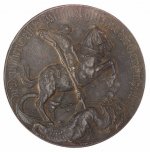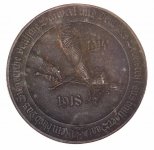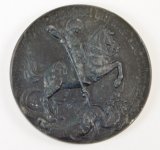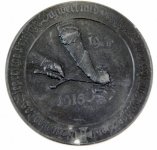Navigation
Install the app
How to install the app on iOS
Follow along with the video below to see how to install our site as a web app on your home screen.
Note: This feature may not be available in some browsers.
More options
You are using an out of date browser. It may not display this or other websites correctly.
You should upgrade or use an alternative browser.
You should upgrade or use an alternative browser.
✅ SOLVED German medallion?
- Thread starter niffler
- Start date
I'm guessing St. George and the Dragon, but beyond that....?
I think you're on the right track here Anduril.

I find a lot of coins here in Canada with this image, we used these 'One Penny & Halfpenny' Tokens from 1850 - 57.
"Saint George is thought to have been born into a noble Christian family in the late third century in what is now modern-day Turkey. As a soldier and officer in the Roman army, he refused to denounce his faith and persecute fellow Christians leading to his martyrdom in 303 AD. The myth of Saint George slaying the dragon originated in stories of his valiance and bravery brought back by the Crusaders who learned of him during the Middle Ages.
Legend has it that George arrived upon a village where a dragon was terrorizing the local people. To appease the creature, they had begun to sacrifice a sheep per day to feed its hunger until they no longer had any sheep. The King then decreed that they must sacrifice the local children to keep the dragon at bay. Each day, the sacrifice was chosen by lottery until the King’s daughter was selected. As she was being led to the dragon, George happened by. Horrified by what he discovered, he offered to slay the dragon. During his battle with the dragon, George noticed a vulnerable patch of skin under its arm and charged forward with his sword, slaying the beast. The villagers held a huge feast in his honor and the feast day of Saint George is celebrated each year in tribute to his bravery.
King Edward III made Saint George the country’s official saint shortly after ascending to the throne in 1327. According to historian Ian Mortimer, a patron saint did not have to be from the country they were born in, they just needed to embody the characteristics the kingdom wanted to project to the outside world: “St. George stands for the courage to face adversity in order to defend the innocent. The triumph of good over evil, through courage. …The king who adopted him might be almost forgotten today, but for centuries Saint George represented the idea of courageous leadership and, with it, the unifying popular will to be governed well and protected.”
Alongside England, Saint George is also the patron saint of Georgia, Malta, Portugal, Catalonia and Aragon in Spain and Romania among others. He is also the patron saint of scouts as well as representing farmers, shepherds and armorers."
Attachments
Upvote
0
Red-Coat
Gold Member
It's St Michael, rather than St George and yes, it is German, since he is their patron saint. Essentially this is a patriotic medal designed to give conviction that Germany would win the First World War with divine support.
There’s an identical one in the collection of the Imperial War Museum in London, although it’s not pictured on their website. The collection record is as follows:
Object description
Obverse design: St Michael in full armour, on horseback facing right, driving his lance into a monster which has the body, long tail and wings of a dragon and eight different animal heads - those of a cock, bear, lion, dog, serpent, monkey, sheep and donkey (see Notes). Obverse text: “Du Deutscher Geist St + Michael hilf uns das Gewürm Zertreten” (embossed Gothic script).
Reverse design: sword, held by a pair of hands wearing fluted Gothic armour gauntlets. The left hand clasps the hilt, the right wipes the blade with a laurel branch. Above the sword the date “1914” and below “1916”. At the base of design a small Iron Cross. Reverse text: “Rein blieb Das Siegreiche Deutsche Schwert und Deutsches Leben reist aus blutiger Saat” (embossed Gothic script).
Label
German First World War medal by the unidentified 'E.T.' [the medal has those initials as a signature] invoking, by means of powerful Gothic imagery, the inspiration and support of the patron saint, St Michael in Germany's unequal struggle against the Allied powers. The enemies are depicted as the grotesque heads of a fearsome dragon and may be identified as follows: cock (France), bear (Russia), lion (England), dog (Belgium), serpent (Italy), monkey (Japan), sheep (Serbia), donkey (pro-Allied neutral). The obverse text is translated as “You German genius St Michael help us to crush the reptiles” and gruesome reverse text as “The victorious German sword remained pure and German life ripens from seed soaked in blood”.
Seemingly, they were still making them to stir up some hope of victory, even after the tide turned against them, since there is an almost identical one in the Royal Greenwich Museum in London, but with the dates as 1914-1918 rather than 1914-1916. These pictures from their website:


There’s an identical one in the collection of the Imperial War Museum in London, although it’s not pictured on their website. The collection record is as follows:
Object description
Obverse design: St Michael in full armour, on horseback facing right, driving his lance into a monster which has the body, long tail and wings of a dragon and eight different animal heads - those of a cock, bear, lion, dog, serpent, monkey, sheep and donkey (see Notes). Obverse text: “Du Deutscher Geist St + Michael hilf uns das Gewürm Zertreten” (embossed Gothic script).
Reverse design: sword, held by a pair of hands wearing fluted Gothic armour gauntlets. The left hand clasps the hilt, the right wipes the blade with a laurel branch. Above the sword the date “1914” and below “1916”. At the base of design a small Iron Cross. Reverse text: “Rein blieb Das Siegreiche Deutsche Schwert und Deutsches Leben reist aus blutiger Saat” (embossed Gothic script).
Label
German First World War medal by the unidentified 'E.T.' [the medal has those initials as a signature] invoking, by means of powerful Gothic imagery, the inspiration and support of the patron saint, St Michael in Germany's unequal struggle against the Allied powers. The enemies are depicted as the grotesque heads of a fearsome dragon and may be identified as follows: cock (France), bear (Russia), lion (England), dog (Belgium), serpent (Italy), monkey (Japan), sheep (Serbia), donkey (pro-Allied neutral). The obverse text is translated as “You German genius St Michael help us to crush the reptiles” and gruesome reverse text as “The victorious German sword remained pure and German life ripens from seed soaked in blood”.
Seemingly, they were still making them to stir up some hope of victory, even after the tide turned against them, since there is an almost identical one in the Royal Greenwich Museum in London, but with the dates as 1914-1918 rather than 1914-1916. These pictures from their website:


Upvote
0
niffler
Hero Member
- Mar 19, 2008
- 908
- 1,368
- 🥇 Banner finds
- 1
- Detector(s) used
- Equinox 900, DFX, Tesoro Tiger Shark, Killer B Hornets, Stealth 720i scoop
- Primary Interest:
- All Treasure Hunting
- Thread starter
- #5
Thank you Red-Coat and everyone who replied. I was considering bidding on this at auction, but as the seller claims it is made of iron I'm less interested than I was.
Upvote
0
Top Member Reactions
-
 3448
3448 -
 1965
1965 -
 1908
1908 -
 1148
1148 -
 1089
1089 -
 1006
1006 -
 876
876 -
 861
861 -
 860
860 -
 776
776 -
 757
757 -
 676
676 -
 653
653 -
 567
567 -
 504
504 -
 451
451 -
 447
447 -
 410
410 -
 403
403 -
E
398
Users who are viewing this thread
Total: 2 (members: 0, guests: 2)











